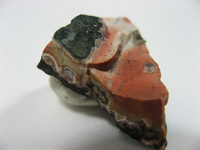![]()
Thomsonite was first identified in material from Kilpatrick Hills, Bunbarton, Scotland in 1820. Thomsonite is named for the Scottish chemist Thomas Thomson. Good samples of thomsonite have been found in The Faroe Islands, Scotland, Colorado, New Jersey, and Oregon in the United States, Nova Scotia Canada, India, and Russia. Nodules of massive thomsonite that display an attractive banded coloring are found along the shore of Lake Superior. Most of these thomsonite nodules and their derived pebbles are less than 0.6 cm (1/4 inch). Those enclosed in basalt are extremely difficult to remove without breaking them. Consequently, a very large percentage of those used as gemstones have been, and continue to be, pebbles collected from beaches. These days, many are recovered off-shore by scuba divers.
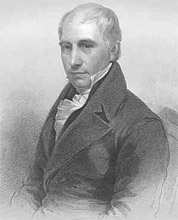 |
Thomas Thomson was born in Crieff, Perthshire in 1773 and died in Kilum in 1852. Thomson was buried at the Glascow Necropolis. Thomson attended the University of St. Andrews to study in classics, mathematics, and natural philosophy. He went on to graduate in medicine from the University of Edinburgh in 1799. However, he was inspired by Joseph Black to take up the study of chemistry. In Mar 1811 he was elected a Fellow of the Royal Society and in 1815 was elected a corresponding member of the Royal Swedish Academy of Sciences. In 1831 he gave silicon its present name. |
![]()
Within the metaphysical realm of minerals, Thomsonite creates a very stable connection between all of the bodies. This mineral helps create a more clear method of thought and assists in dealing with situations someone if trying to solve. This allows the believer's brain to work at a maximum level and for them to see what is truly going on and how to solve it. Thomsonite helps dissolve laziness. Thomsonite encourages growth on all levels and also helps to remove blockages which have presented this growth.
Please note that MIROFOSS does not suggest in any way that minerals should be used in place of proper medical and psychological care. This information is provided here as a reference only.
![]() Thomsonite is generally used as a semi-precious gemstone.
Thomsonite is generally used as a semi-precious gemstone.
![]()
Thomsonite occurs with other zeolites in the amygdaloidal cavities of basaltic volcanic rocks, and occasionally in granitic pegmatites.
![]()
The crystal system of thomsonite is orthorhombic. The crystals tend to be long thin blades that typically form radial aggregates, and sometimes fans and tufts. The aggregates are variable and may be spiky in appearance, dense and ball-like, or form worm-like growths. Tight acicular radiating clusters and sphericules are common forms. Thomsonite is one of the rarer zeolites found on the Earth.
Other than in the basic mineral form, thomsonite can be found in one distinct variety:
![]()
| Cleavage | Perfect to Good | |
| Colour(s) | Colourless, Green, Yellow, White, Pink | |
| Specific Gravity | 2.34 | |
| Diaphaneity | Translucent to Opaque | |
| Fracture | Conchoidal - Fractures developed in brittle materials characterized by smoothly curving surfaces | |
| Mohs Hardness | 5.0 to 6.5 | |
| Luminescence | Non-fluorescent | |
| Lustre | Vitreous | |
| Streak | White | |
| Habit(s) | Fibrous to Radial to Spherical | |
| Radioactivity | Non-radioactive | |
| Magnetism | Non-magnetic | |
| Electrical | Non-Electric |
![]()
No known health risks have been associated with thomsonite. However ingestion of thomsonite, as with other naturally occurring minerals, is not recommended.
![]()
The following image shows the Elemental breakdown of the mineral thomsonite along with the mineral crystal structure.
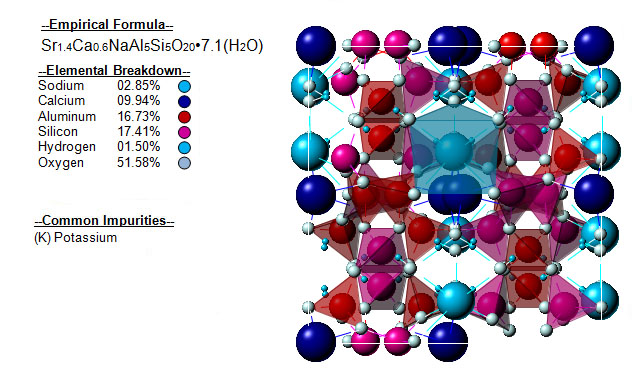
![]()
| Crystal System | Orthorhombic |  |
| Class | Dipyramidalc | |
| Axial Ratios | a : b : c = 1.0036 : 1 : 1.0145 | |
| Morphology | Crystals commonly prismatic, acicular, bladed, massive | |
| Optical Data Type | Biaxial (+) | |
| Pleochroism (x) | Colourless | |
| Pleochroism (y) | Colourless | |
| RL Values | nα = 1.511 - 1.530 nβ = 1.513 - 1.532 nγ = 1.516 - 1.545 |  |
| 2V | Measured: 44° to 75°, Calculated: 44° to 80° | |
| Max Birefringence | δ = 0.005 - 0.015 (See colour chart at right) | |
| Surface Relief | Low | |
| Dispersion | Strong r > v | |
![]()
Thomsonite can be referenced in certain current and historical texts under the following nineteen names:
The mineral thomsonite can be translated into the following select languages:
| Arabic | Bulgarian | Chinese (Sim) | |||
| Croatian | Czech | Danish | |||
| Dutch | Esperanto | Estonian | |||
| Finnish | French | German | Bagotit | ||
| Greek | Hebrew | Hungarian | |||
| Italian | Japanese | トムソン | Korean | ||
| Latin | Lithuanian | Norwegian | |||
| Persian | Polish | Portuguese | |||
| Romanian | Russian | Томсонит | Slovak | ||
| Spanish | Bagotita | Swedish | Tagalog | ||
| Turkish | Ukrainian | Томсон | Vietnamese |
![]()
Thomsonite can be found in a few places around the world. The map below shows major documented concentrations of thomsonite:
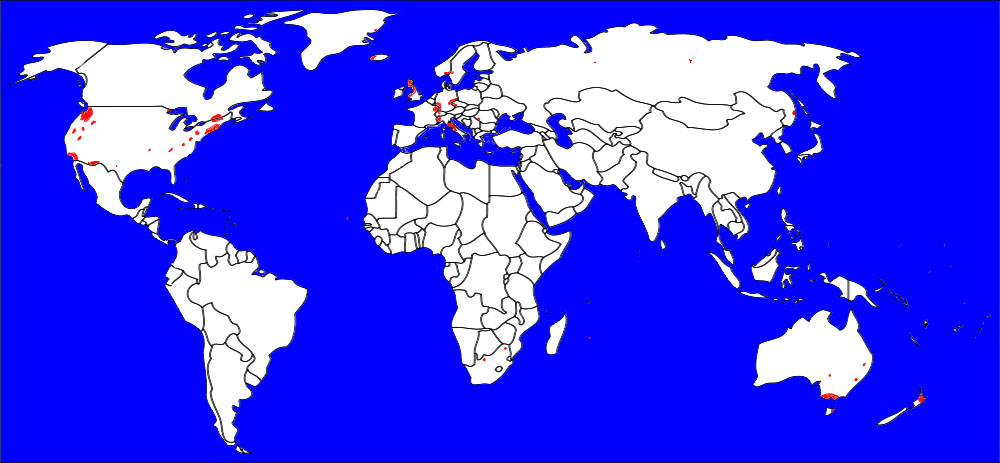
![]()
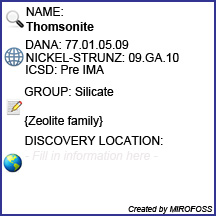 |
The MIROFOSS database offers free printable geological identification tags for personal and non-profit use. These tags can be used to properly identify mineral samples in your collection. -Click here- to download a full size jpeg image for a thomsonite identification tag; which can be printed on paper or used with a plastic laser printer. |
 |
What's this? What can I do with it? |
![]()
| Chemical Composition | Gatta, G. D., Kahlenberg, V., Kaindl, R., Rotiroti, N., Cappelletti, P. and de’ Gennaro, M. (2010): Crystal structure and low-temperature behavior of “disordered” thomsonite. American Mineralogist 95, 495-502 |
| Crystallography | Wise, W. S. & Tschernich, R. W. (1978): Habit, crystal forms and composition of thomsonite. Can. Mineral. 16, 487-493 |
| Optical Data | Kol’tsova, T. N. (2005): Zeolites of the natrolite-thomsonite series. Inorganic Materials, 41, 750-756 |
| History | American Mineralogist (1992): 77: 685 |
| Geographical Data | Mindat.org. Retrieved on 2012-03-01 |
| Physical Identification | Webmineral.com. Retrieved on 2012-03-01. |
| March 03, 2012 | The last time this page was updated |
| ©2017 MIROFOSS™ Foundation | |
 |
|

